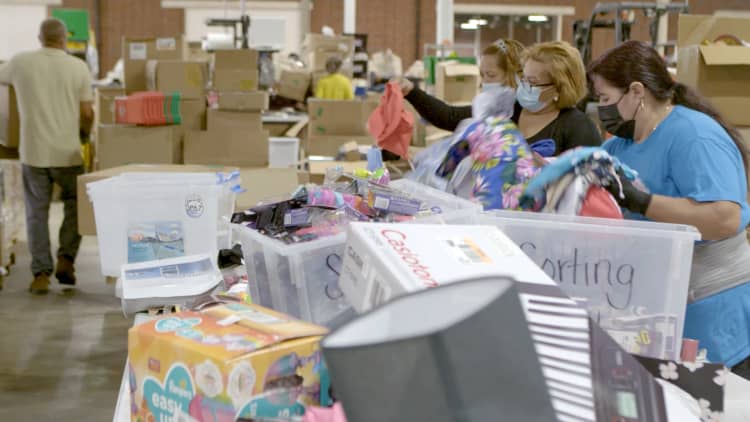
Alicia Silverstone stars in the 1995 film “Clueless.”
Stringer | Array | Reuters
Her character Cher Horowitz may have been best known for her shopping habit, but in real life, “Clueless” star Alicia Silverstone said she never buys retail if she can help it.
“Cher, she is such a consumer. We are actual opposites,” the sustainability advocate and actor told CNBC. “My mantra with purchasing anything: It needs to be used first.”
Silverstone adopted a more sustainable approach to consumption years ago.
“I’ve been fighting the good fight to encourage people to buy used and make it sound cool,” she said.
More consumers are catching on.
“I do think people are getting more concerned about the planet, so they are interested in buying preloved,” said Silverstone, who partnered with eBay to promote its first Recommerce Day, on May 21. “We are not just screaming into a dark hole anymore.”
Online shopping’s hefty toll on the environment
With the explosion of online shopping during the pandemic, a surge in returns seemed like a small price for everyone to pay.
Then, as customers got increasingly comfortable with their buying and returning habits, more shoppers began ordering products they never intended to keep. Nearly two-thirds of consumers now buy multiple sizes or colors, some of which they then send back, a practice known as “bracketing.”
The return rate in 2023 was about 15% of total U.S. retail sales, or $743 billion in returned goods, according to the National Retail Federation’s most recent data. For online sales, the numbers are even higher, with a return rate closer to 18%, or $247 billion of merchandise purchased online returned.

But all of that back and forth comes at a hefty price.
In fact, processing a return costs retailers an average of 30% of an item’s original price, according to returns solution company Optoro.
“The bedroom has become the new dressing room,” said Amena Ali, Optoro’s CEO. “It’s Pandora’s box, because once you go there, you can’t get back.”
For their part, companies have been quietly attempting to keep returns in check.
Last year, 81% of U.S. retailers rolled out stricter return policies, including shortening the return window and charging a return or restocking fee, according to a report from return management company Happy Returns. Others, including Amazon and Target, have simply told shoppers to “keep it.”
More from Personal Finance:
Miami is ‘ground zero’ for climate risk
Why climate change may cost you big bucks
8 easy — and cheap — ways to cut your carbon emissions
“Charging for returns is one way to cover a portion of that cost,” Erin Halka, senior director at Blue Yonder, a supply chain management company, told CNBC in 2022. “It also can deter customers from overbuying, since at least 10% of returned goods cannot be resold.”
But returns aren’t just an issue for retailers’ bottom line.
“Often returns do not end up back on the shelf,” and that also causes a problem for retailers struggling to enhance sustainability, according to Spencer Kieboom, founder and CEO of Pollen Returns, a return management company.
Also referred to as reverse logistics, sending products back to be repackaged, restocked and resold — sometimes overseas — is “like playing a tape in reverse,” Ali said.
And it generates even more carbon emissions to get those items back in circulation, if they even make it that far. In some cases, returned goods are sent straight to landfills, while only 54% of all packaging is recycled, according to the U.S. Environmental Protection Agency.
Last year’s returns created 8.4 billion pounds of landfill waste, according to Optoro.
“People are perhaps more aware of fast fashion in terms of waste, but the same adage applies to really everything you are returning,” Ali said.
Out of a returns problem comes a liquidation boom
Where there is a returns problem, there is also an opportunity, especially for those in the liquidation business.
“Most retailers do not restock returns. It is way too capital and labor intensive for them to do so,” said Shraysi Tandon, co-founder and CEO of Kidsy, an e-commerce company that resells children’s product overstock, open-box and returned goods.
However, “returns is an issue they want to fix,” she added, which is why some retailers now sell returns to businesses such as Kidsy that buy products in bulk. “These partnerships are beneficial.”

Consumers can also benefit, while cutting down on emissions and landfill waste.
The environmental advantages now rank among the top reasons shoppers have embraced so-called recommerce, second only to saving money, according to a recent report by eBay. As more shoppers jump on board, driven by a pursuit of value and a desire to shop in more sustainable ways, the stigma around buying secondhand is all but gone.
Over the next five years, recommerce is projected to grow more than four times faster than the broader retail market and hit $276 billion by 2028, a recommerce report by OfferUp found.
While the industry is dominated by clothing resale, 85% of Americans now buy or sell secondhand products, OfferUp found, including electronics, furniture, home goods and sporting equipment, as well as apparel. Children’s goods are a natural fit, Tandon said: “Parents have been engaged in the hand-me-down culture long before a formal marketplace existed.”
Silverstone said that’s how her mom raised her, even if it meant wearing her older brother’s “itchy sweaters.” And that’s how she outfits her son, Bear, who prefers “hip shoes.”
“If I get it used, I feel better about it,” she said of buying the latest hot sneakers.
Even Cher came around to the idea in the end of the movie, Silverstone added, when she led a donation drive at her school. “She has a big heart, so she learned there’s another way.”
In this new series, CNBC will examine what climate change means for your money, from retirement savings to insurance costs to career outlook.
